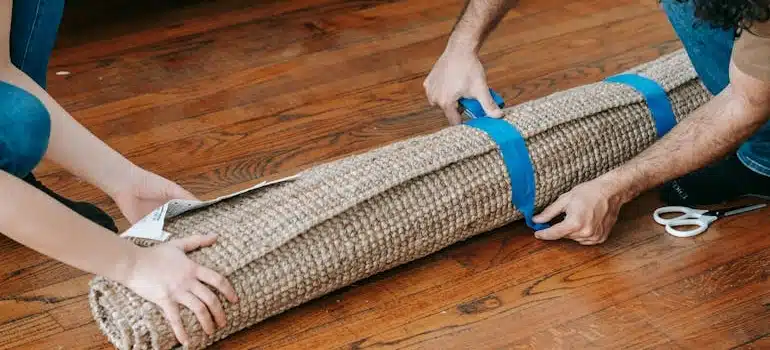Pack and move large area rugs with ease
Large rugs take up floor space—and planning space. If you’ve got one or more to move, it helps to treat them like furniture, not decor. They’re bulky, they hold dust, and they don’t fold like blankets. The wrong packing method can leave permanent creases, damage the fibers, or trap moisture during transport. This Pro Movers Miami guide shows you how to pack and move large area rugs the right way, from identifying the material to wrapping and placing them safely in the truck.
Know your rug before doing anything else
Start by checking the label. You’ll want to know the rug’s material and backing before you clean it. Wool and silk need more care than synthetics. Jute or sisal can’t handle moisture. Backings vary too—some are cotton, some latex, some a plastic mesh.
If your rug is handmade or antique, don’t use regular cleaners or tape. If it’s synthetic and machine-made, you can be a bit more hands-on. Getting this part right helps avoid mistakes during every step that follows.

Moving antiques or oversized rugs? Plan ahead
Before you pack and move large area rugs, know that some are too large or too valuable for DIY packing. Measure your doorways and staircases before moving day. If it won’t fit, you may need to crate it or arrange separate transport.
Antique rugs often need custom wrapping. Some high-end movers offer this service, or you can check with a local rug store for help. If the rug is worth a lot, consider temporary insurance for the move.
Give it a good clean—but do it right
Don’t roll up a dirty rug. Dust, crumbs, and moisture can ruin the fibers if left trapped inside. Start by vacuuming both sides. If it’s delicate, skip the beater bar and use suction only. Spot clean any stains with a mild detergent or rug cleaner. Use as little water as possible, and make sure the rug is fully dry before you pack it.
In many cities, rug cleaning services will handle this for you and even prep it for storage. If you’re moving something valuable or fragile, that’s often worth the price.
Roll it the right way—never fold
Never fold a rug. Even one hard crease can leave permanent damage. Always roll it up, and keep the pile on the inside. That protects the surface and helps it keep its shape.
If the rug is longer than 6 feet, get a core, like a PVC pipe or carpet roll. You can find those at hardware stores. Rolling the rug around a core helps it stay round and keeps the edges from curling. Don’t roll too tightly. Gentle pressure is enough.

Secure it with soft ties, not tape
It is vital to know which packing supplies to use and where to find them. After rolling, use cotton ties or soft straps to hold the rug in place. Don’t use duct tape or rope. These can dig into the fibers or leave sticky marks. One tie near each end and one in the center is enough.
If you used a core, pad the ends with cloth or cardboard to prevent bumps or tears. This is especially helpful during loading and unloading.
Wrap it in something that lets it breathe
If you need to pack and move large area rugs, you’ll want to wrap them to protect them from dust and dirt. For longer moves or storage, use breathable materials like cotton sheets or muslin. For short moves, clear stretch wrap is fine, but poke a few holes to let air in.
Avoid trash bags or plastic bubble wrap. These trap moisture, and that leads to mold. For expensive rugs, consider buying a rug sleeve or bag made for shipping and using climate-controlled storage. Label the roll clearly so no one stacks anything heavy on it.
Place it carefully in the truck
Rugs can get crushed if they’re buried under other items. Lay the rolled rug on top of lighter boxes or wedge it upright against the truck wall. If it shifts around, pad it with blankets or other soft items to keep it in place.
Don’t leave it in a garage or truck overnight unless the space is dry and cool. Rugs left in hot or humid areas can warp or grow mildew, even if they were clean to start with.
Watch the weather and your storage space
Climate matters, especially if you’re moving in or out of Florida. High humidity is bad for natural fibers, so learn what to expect from Florida weather. On the other hand, cold air can make some backings brittle.
If you’re putting the rug in storage, always choose a climate-controlled unit. Avoid basements, attics, or sheds unless they’re dry and sealed. If pests are a concern, toss in a few cedar blocks or lavender sachets before wrapping. Just don’t let anything sit directly on the rug’s surface.

Let it rest before using it again
Once you’ve moved in, give the rug time to adjust. Let it sit in its wrap for a few hours before unrolling. If it’s stiff or curled at the edges, place a few books at each corner. That usually helps it flatten out naturally.
Don’t put heavy furniture on it right away. Wait a day or two, if possible. Then vacuum it gently to lift the pile. If the rug smells off, let it air out near a window.
Know when to call in help
You don’t need to do it all yourself. If the rug is too heavy to carry, or too fragile to wrap without help, bring in the pros. Many white glove movers near you offer specialty services for large rugs. This includes padded wrapping, climate-controlled storage, and safe transport.
Ask about rug-specific options when booking your move. It might cost more, but it can prevent damage that’s expensive—or impossible—to fix later.
Don’t let your rug roll out the wrong way
Rugs might look simple, but they’re easy to mishandle. One wrong fold or rushed wrap job can cause lasting damage. A little care goes a long way. Whether you need to pack and move large area rugs across the street or the country, taking a few extra steps to prepare for packing now helps them arrive in good shape and ready to use.
